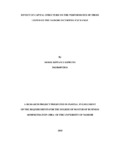| dc.description.abstract | This research paper sought to find out the effect of capital composition on the performance of firms listed on the exchange, Nairobi Securities Exchange (NSE). This research study primarily concentrated on 65 companies operating in Kenya and are listed on the Nairobi Securities Exchange (NSE) for the financial period spanning 5 years; from 2013 to 2017. Business firms were chosen based on the availability of information crucial for conducting the research study. Out of 65 listed companies on the NSE, only 60 had complete data as per this study requirements, representing 92% response rate. The study engaged descriptive research model and applied return on asset (ROA) as explained variable as well as two capital composition measures: TDTA and TDTE as explanatory variables. The research also incorporated size and growth as control variables. Regression analysis was applied on ROA, Return on Assets, as well as total debt to total assets, TDTA, and Total debt to Equity, TDTE, as capital composition variables and size (S) and growth (G) as control variables to determine the effects of capital composition on the performance of companies listed at the NSE. The regression results showed a strong positive relationship between capital composition and performance. This is so because the multiple R (+ 0.5572) approached + ve 1. The multiple regression results also showed that, 31.05% of the changes in the performance of business firms listed on the NSE is attributed to capital composition decisions while the 68.95% of the changes in the ROA of business firms could be attributed to other factors outside this study. Further, the regression results revealed a negative relationship between TDTA and ROA; while TDTE is positively correlated to ROA. The multiple regression results indicate that size and growth have a positive association with ROA. The sectoral regression analysis revealed a strong positive relationship between explanatory variables and explained variable for largely all the sectors since their multiple R(s) approached + ve. The work concludes that capital composition has a moderate positive relationship with ROA and positively affects the performance of firms listed on the NSE. It suggested that managers should consider using debt relative to equity since it affects their company’s performance positively. It also recommends that managers should exercise due caution on the debt risk of the asset to be financed as TDTA has a negative relationship with ROA. | en_US |



